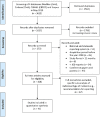Addressing Patient Safety Hazards Using Critical Incident Reporting in Hospitals: A Systematic Review
- PMID: 35985209
- PMCID: PMC9788933
- DOI: 10.1097/PTS.0000000000001072
Addressing Patient Safety Hazards Using Critical Incident Reporting in Hospitals: A Systematic Review
Abstract
Introduction: Critical incident reporting systems (CIRS) are in use worldwide. They are designed to improve patient care by detecting and analyzing critical and adverse patient events and by taking corrective actions to prevent reoccurrence. Critical incident reporting systems have recently been criticized for their lack of effectiveness in achieving actual patient safety improvements. However, no overview yet exists of the reported incidents' characteristics, their communication within institutions, or actions taken either to correct them or to prevent their recurrence. Our main goals were to systematically describe the reported CIRS events and to assess the actions taken and their learning effects. In this systematic review of studies based on CIRS data, we analyzed the main types of critical incidents (CIs), the severity of their consequences, their contributing factors, and any reported corrective actions.
Methods: Following the Preferred Reporting Items for Systematic Reviews and Meta-Analyses guidelines, we queried MEDLINE, Embase, CINAHL, and Scopus for publications on hospital-based CIRS. We classified the consequences of the incidents according to the National Coordinating Council for Medication Error Reporting and Prevention index, the contributing factors according to the Yorkshire Contributory Factors Framework and the Human Factors Classification Framework, and all corrective actions taken according to an action hierarchy model on intervention strengths.
Results: We reviewed 41 studies, which covered 479,483 CI reports from 212 hospitals in 17 countries. The most frequent type of incident was medication related (28.8%); the most frequent contributing factor was labeled "active failure" within health care provision (26.1%). Of all professions, nurses submitted the largest percentage (83.7%) of CI reports. Actions taken to prevent future CIs were described in 15 studies (36.6%). Overall, the analyzed studies varied considerably regarding methodology and focus.
Conclusions: This review of studies from hospital-based CIRS provides an overview of reported CIs' contributing factors, characteristics, and consequences, as well as of the actions taken to prevent their recurrence. Because only 1 in 3 studies reported on corrective actions within the healthcare facilities, more emphasis on such actions and learnings from CIRS is required. However, incomplete or fragmented reporting and communication cycles may additionally limit the potential value of CIRS. To make a CIRS a useful tool for improving patient safety, the focus must be put on its strength of providing new qualitative insights in unknown hazards and also on the development of tools to facilitate nomenclature and management CIRS events, including corrective actions in a more standardized manner.
Copyright © 2022 The Author(s). Published by Wolters Kluwer Health, Inc.
Conflict of interest statement
The authors disclose no conflict of interest.
Figures
Similar articles
-
Critical incident reporting over time: a retrospective, descriptive analysis of 5493 cases.Swiss Med Wkly. 2021 Dec 28;151:w30098. doi: 10.4414/smw.2021.w30098. eCollection 2021 Dec 20. Swiss Med Wkly. 2021. PMID: 34964949
-
[Findings from 10 years of CIRS-AINS : An analysis of usepatterns and insights into new challenges].Anaesthesist. 2020 Nov;69(11):793-802. doi: 10.1007/s00101-020-00829-z. Epub 2020 Aug 17. Anaesthesist. 2020. PMID: 32808047 Free PMC article. German.
-
[17 years of the critical incident reporting and learning system "jeder-fehler-zaehlt.de" for primary care: Analysis of reports].Z Evid Fortbild Qual Gesundhwes. 2024 Apr;185:10-16. doi: 10.1016/j.zefq.2023.12.007. Epub 2024 Feb 15. Z Evid Fortbild Qual Gesundhwes. 2024. PMID: 38360509 German.
-
Learning from safety incidents in high-reliability organizations: a systematic review of learning tools that could be adapted and used in healthcare.Int J Qual Health Care. 2021 Mar 17;33(1):mzab046. doi: 10.1093/intqhc/mzab046. Int J Qual Health Care. 2021. PMID: 33729493 Free PMC article.
-
Critical incident reporting and learning.Br J Anaesth. 2010 Jul;105(1):69-75. doi: 10.1093/bja/aeq133. Br J Anaesth. 2010. PMID: 20551028 Review.
Cited by
-
Learning from experience: a qualitative study of surgeons' perspectives on reporting and dealing with serious adverse events.BMJ Open Qual. 2023 Jun;12(2):e002368. doi: 10.1136/bmjoq-2023-002368. BMJ Open Qual. 2023. PMID: 37286299 Free PMC article.
-
Nurse judgements of hospitalized patients' safety concerns are affected by patient, nurse and event characteristics: A factorial survey experiment.J Clin Nurs. 2025 Feb;34(2):493-506. doi: 10.1111/jocn.17372. Epub 2024 Jul 15. J Clin Nurs. 2025. PMID: 39008405 Free PMC article.
-
The effectiveness of checklists and error reporting systems in enhancing patient safety and reducing medical errors in hospital settings: A narrative review.Int J Nurs Sci. 2024 Jun 8;11(3):387-398. doi: 10.1016/j.ijnss.2024.06.003. eCollection 2024 Jul. Int J Nurs Sci. 2024. PMID: 39156684 Free PMC article. Review.
-
Critical airway-related incidents and near misses in anaesthesia: a qualitative study of a critical incident reporting system.Br J Anaesth. 2024 Aug;133(2):371-379. doi: 10.1016/j.bja.2024.04.052. Epub 2024 Jun 12. Br J Anaesth. 2024. PMID: 38866639 Free PMC article.
-
Enhancing patient safety: detection of in-hospital hazards and effect of training on detection (by training in a low-fidelity simulation Room of Improvement based on hospital-specific CIRS cases).BMJ Open Qual. 2024 May 29;13(2):e002608. doi: 10.1136/bmjoq-2023-002608. BMJ Open Qual. 2024. PMID: 38816004 Free PMC article.
References
-
- Buckley TA Short TG Rowbottom YM, et al. . Critical incident reporting in the intensive care unit. Anaesthesia. 1997;52:403–409. - PubMed
-
- World Health Organization . Patient safety incident reporting and learning systems: technical report and guidance. Geneva, Switzerland: World Health Organization; 2020;2020.
-
- Institute of Medicine Committee on Quality of Health Care in America , Kohn LT, Corrigan JM, Donaldson MS, eds. To Err Is Human: Building a Safer Health System. In: Washington, DC: National Academies Press (US); 2000. - PubMed
-
- Bundesaerztekammer . Gesetz zur Verbesserung der Rechte von Patientinnen und Patienten 2013. Available froat: https://www.bundesaerztekammer.de/fileadmin/user_upload/downloads/Patien.... Accessed March 7, 2021.
-
- Bundesamt für Gesundheit . Qualität und Patientensicherheit 2020. Available at: https://www.bag.admin.ch/bag/de/home/versicherungen/krankenversicherung/.... Accessed October 17, 2020.
Publication types
MeSH terms
LinkOut - more resources
Full Text Sources
Medical





